Specially selected posts from this blog’s archive are now featuring on Flashbak, the digital resource featuring images and stories from the past.
Rock, Rock, Rock! Roots of Let It Rock’s Chuck Berry t-shirt in 50s movie ephemera
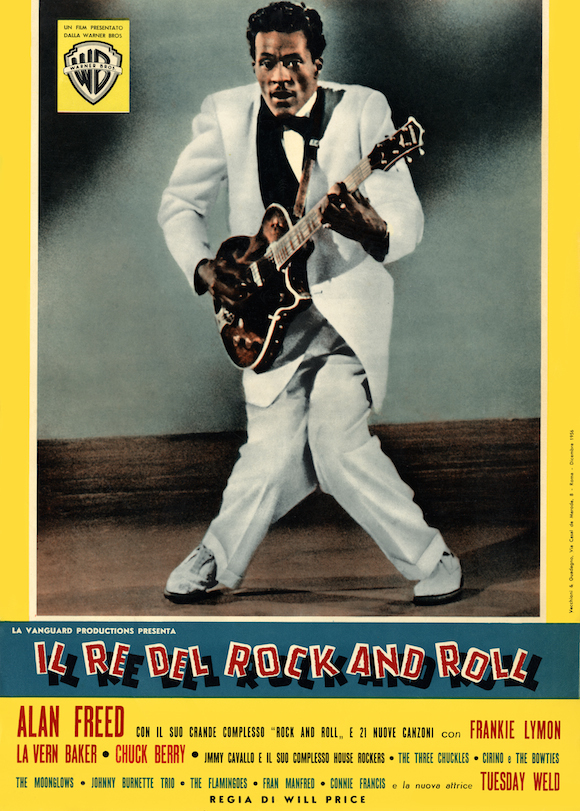
//Poster for Italian release of Alan Freed’s 1956 musical Rock, Rock, Rock!. Photo: John D. Kisch/Separate Cinema Archive/Getty Images//
//Left: Chuck Berry image isolated and bleached out. Right: As it appeared on the t-shirt, worn in this 1973 photograph of singer/songwriter Simon Fisher Turner. Photographer: Unknown//
When they were setting up Let It Rock in 1971, Malcolm McLaren and his original partner in the boutique at 430 King’s Road – Patrick Casey – acquired a cache of posters, showcards and ephemera for 50s rocksploitation movies, including many Continental-language variants.
Found! The source of the Jerry Lee image in Let It Rock’s Killer Rocks On t-shirt

//Lobby card for High School Confidential!, 1958. This is from the opening scene, where Lewis sings the movie’s title track//
Let It Rock was digging in the ruins of past cultures that you cared about. It was giving them another brief moment in the sun. It wasn’t about doing anything new. It was an homage. It was nostalgia.
Malcolm McLaren to Momus, 2002
Forty three years after its creation I can reveal the source of the Jerry Lee Lewis image which appeared on the Let It Rock t-shirt design “The ‘Killer’ Rocks On!”.
It is from a lobby card for Alan Freed’s 1958 rocksploitation flick High Street Confidential!; an original was just one of the pieces of 50s ephemera adorning Let It Rock’s premises at 430 King’s Road in 1972.
‘This country is run by a group of Fascists’: When Malcolm McLaren met Sweet Gene Vincent backstage at The Marquee
//Clockwise from top left: Gene Vincent with one of The Houseshakers, Magnet Club, Chelmsford, UK, February 1971. Photo: http://gene.vincent.fanclub.voila.net; Let It Rock assistant in Gene Vincent and the Blue Caps top, Wembley Stadium, August 5, 1972. Photo: Masayoshi Sukita; Vincent’s quote as featured on the Sex t-shirt You’re Gonna Wake Up, 1974//
‘Gene Vincent for me was the embodiment of rock’n’roll’
Malcolm McLaren 1997
On September 22 1971, Gene Vincent was a mid-week booking to play a “rock revival” night at central London club The Marquee.
Times were tough; at just 36, the soft-spoken American rocker was apparently way past his heyday and beset by severe health problems brought on by the combination of alcoholism and addiction to prescription drugs taken to dull the constant pain in his left leg. This was the result of a crippling motorbike accident in his youth and the lingering effects of having been in the 1960 car-crash which killed Eddie Cochran.
Malcolm McLaren exhibition: Let It Rock x Let’s Rock x Little Richard = Vive Le Rock!

//Malcolm McLaren in front of display of Belgian 50s rock n roll movie posters inside Let It Rock, 430 King’s Road, January 1972. Note Vive le Rock! poster top left. Photo: David Parkinson//
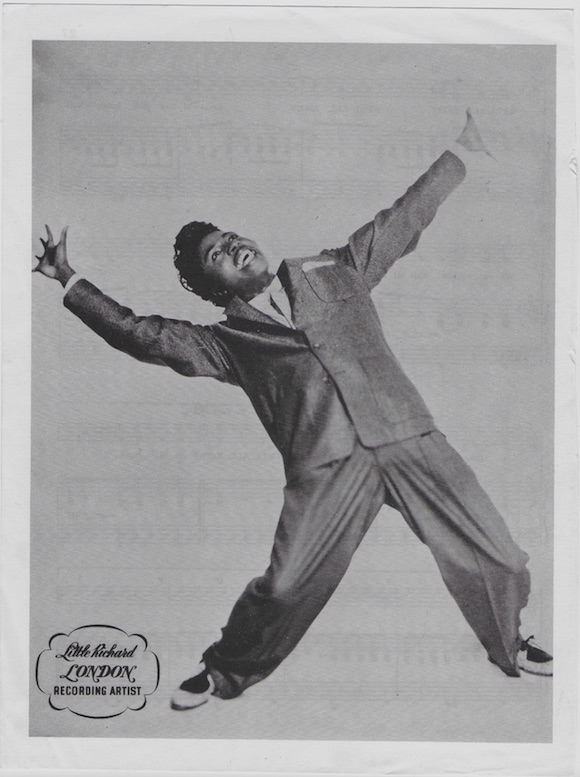
//Taken by John E. Reed in 1956 to promote teen-movie Don’t Knock The Rock, the photo was reissued by London Records to mark the release of the four-track EP Little Richard And His Band//
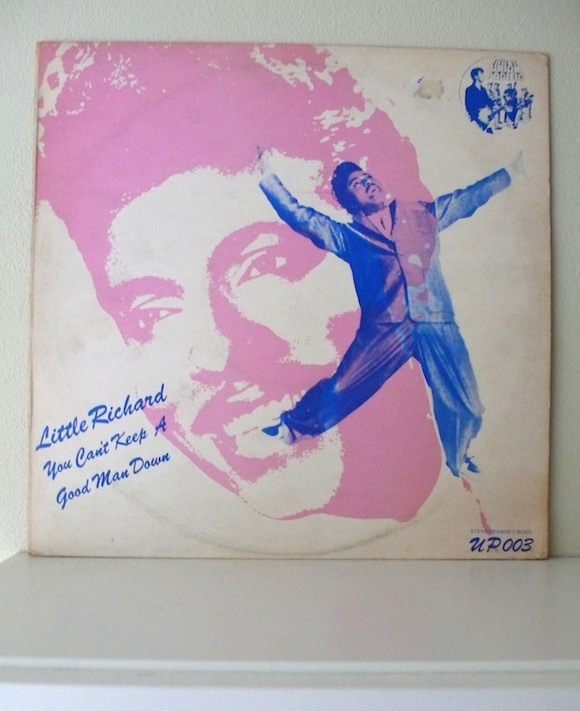
//Front cover, You Can’t Keep A Good Man Down, Little Richard, Union Pacific, 1972. Designer: Unknown//
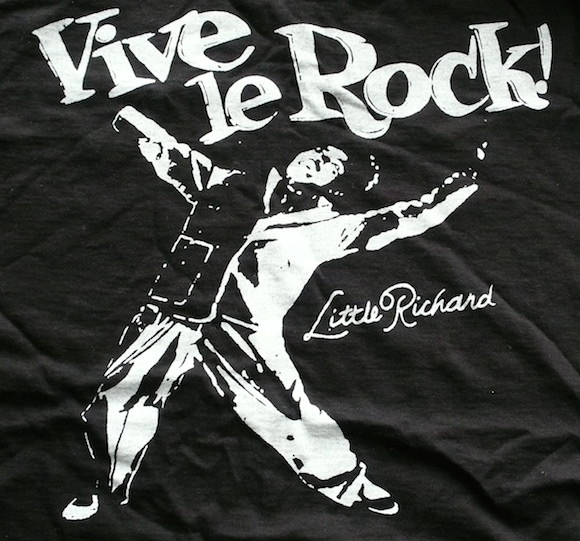
//As shown on this repro, McLaren’s design for the Little Richard shirt sold at the London Rock N Roll Festival held at Wembley Stadium in August 1972//
Yet another example of Malcolm McLaren’s astounding design talent is examined across a number of exhibits at the Let It Rock show, which opens at Copenhagen’s Bella Center on Sunday (August 3).
In 1972 McLaren expanded his investigations into 50s pop design culture by producing a series of t-shirt designs celebrating the great American rock & roll stars performing on the bill of the one-day festival at London’s Wembley Stadium that August.
McLaren continued to followed the path dictated by his formidable art education by creating new artworks out of the juxtaposition of found objects. A 1956 promotional photograph of Little Richard provided the main image for the shirt dedicated to The Georgia Peach.
In 1972 it also appeared on the cover of the UK compilation You Can’t Keep A Good Man Down; that year also witnessed a revival of interest in the pompadoured Richard Penniman after Let It Rock customer Charles (now Lord) Saatchi featured a Little Richard song in a 50s-styled TV advert for Libro jeans.
McLaren flipped the image, reversed it out and positioned the exuberant figure with the joyous title lettering from a rock & roll movie poster he stocked in Let It Rock. Vive Le Rock! was, in fact, the French title of the 1958 US production Let’s Rock, so tied indirectly with the name McLaren had chosen for his own venture. In Britain the film was marketed under the tamer Keep It Cool.
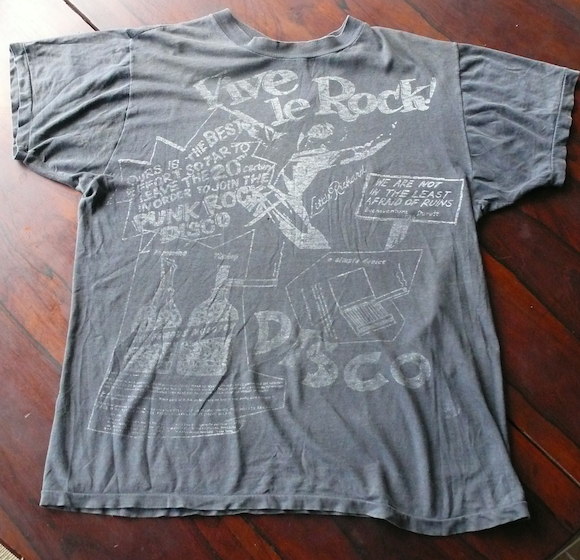
//McLaren later incorporated the Vive Le Rock! elements into a fresh composite for sale in 430 King’s Road when it was Seditionaries in 1979. This also featured Situationist slogans, a quote from the early 20th century Spanish anarcho-syndicalist Buenaventura Durruti and “recipes” from William Powell’s The Anarchist’s Cookbook, first published in 1971//
The Copenhagen show features a Let It Rock installation complete with a series of large prints of previously unseen photographs taken by David Parkinson inside 430 King’s Road in January 1972. Included is a full version of the image at the top of this post, as well as a Vive le Rock! shirt and the Little Richard LP cover.
Let It Rock: The Look Of Music The Sound Of Fashion is at the Crystal Hall in Copenhagen’s Bella Center from August 3-6.
Read more here.
*This post was revised and updated to reflect fresh information on the source of the image on March 11, 2017*
The Teds are back: McLaren + Westwood’s Let It Rock in the NME and the Evening Standard August 1972
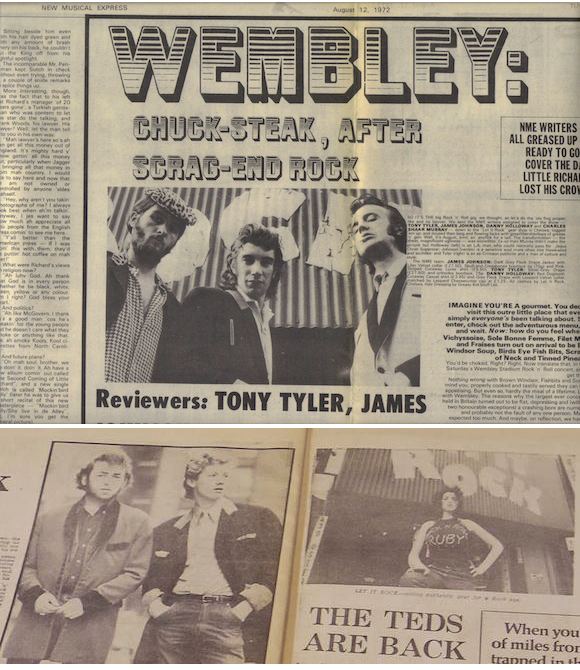
//TOP: From the NME’s coverage of the Wembley Rock N Roll Show – staff model Let It Rock clothing outside 430 King’s Road. Photo: Robert Ellis./ABOVE: From the Evening Standard special issue – Teds and (left) LIR assistant Addie Isman outside Let It Rock.//
As a follow-up to my recent post about the Rock N Roll revival show held at London’s Wembley Stadium in August 1972, here is another selection from the media surrounding the event.
The New Musical Express dedicated a section to reviewing the show, decking staffers Danny Holloway, James Johnston and the late Tony Tyler in appropriate clothing from Let It Rock. The journalists were photographed outside Malcolm McLaren and Vivienne Westwood’s outlet at 430 King’s Road by Robert Ellis.
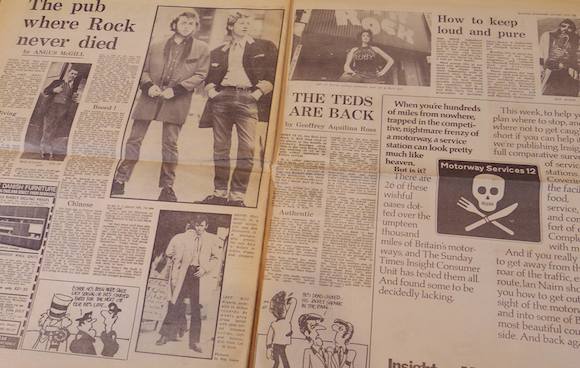
//Angus McGill and Geoffrey Aqulina Ross were among the journalists who contributed to the ES special. I love the juxtaposition with the knife and fork/skull and crossbones logo promoting a Sunday Times feature by the architectural writer Ian Nairn, whose work has recently undergone critical appraisal//
The capital’s daily paper the Evening Standard’s special issue – billed as the official programme – also included images taken outside Let It Rock, including assistant Addie Isman in one of the store’s then-new studded t-shirts (this one emblazoned with the phrase Rock N Roll Ruby) and customer and prominent London Ted Bill Hegarty in full regalia.
The images of the Evening Standard special issue are from the copy owned by collector Takeshi Hosoya, whose Japanese clothing label Peel + Lift can be viewed here.
Many thanks to Robert Ellis for permission to use his shot in the scan from the NME. Visit Robert Ellis’s Repfoto site here.
The London Rock n Roll Show at Wembley Stadium 1972: Memories of Oz, Frendz and the Let It Rock stall
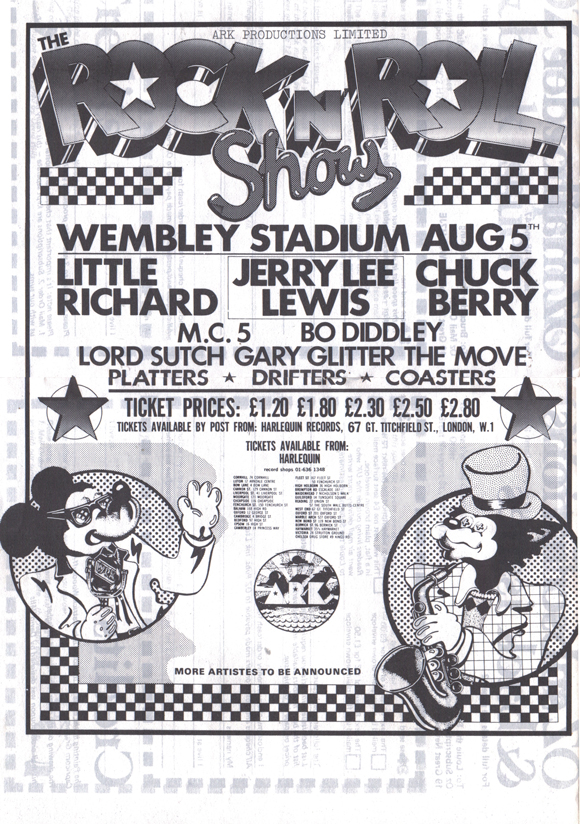
//Flyer for The Rock n Roll Show printed on the back of a subscription form for Oz magazine, July 1972. The Move were replaced by lead member Roy Wood’s new band Wizzard; this was their first gig. Original Brit-rocker Heinz was added to the bill; his backing band would soon become Dr Feelgood//
I acquired my first underground press publications in the summer of 1972, at about the point when the sector was taking the nosedive from which it never recovered.
Still, better late than Sharon Tate, as they say. Aged 12, my taste had been whetted by sneak peeks at an older brother’s collection of magazines when a guy called Kevin O’Keefe who lived down the road gave me a few copies of Oz, including number 43, the July issue.
A few weeks later, to my astonishment, the newsagents in Hendon’s Church Road started stocking Frendz. I folded issue 33 between a couple of music papers and pored over it in my bedroom.
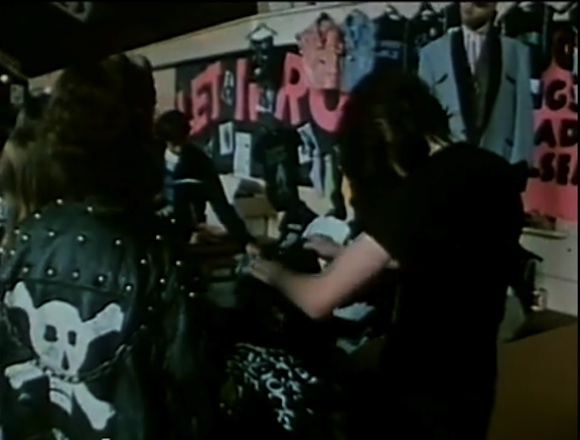
//Crowds around the Let It Rock stand. From the 1973 film London Rock N Roll Show directed by Peter Clifton//
Neither of the magazines are shining examples of the genre, but they had something in common: the centre spread of OZ 43 contained a subscription form back-printed with a flyer for the London Rock N Roll Show, a one-day festival of original 50s acts and those who could claim kinship held at Wembley Stadium on August 5 that year.
And for me the most beguiling article in Frendz 33 was a two-page stream-of-consciousness report of the event filed by one Douglas Gordon and illustrated with photographs by Pennie Smith, soon to leave for the NME and carve out her reputation as one of rock photography’s all-time greats.

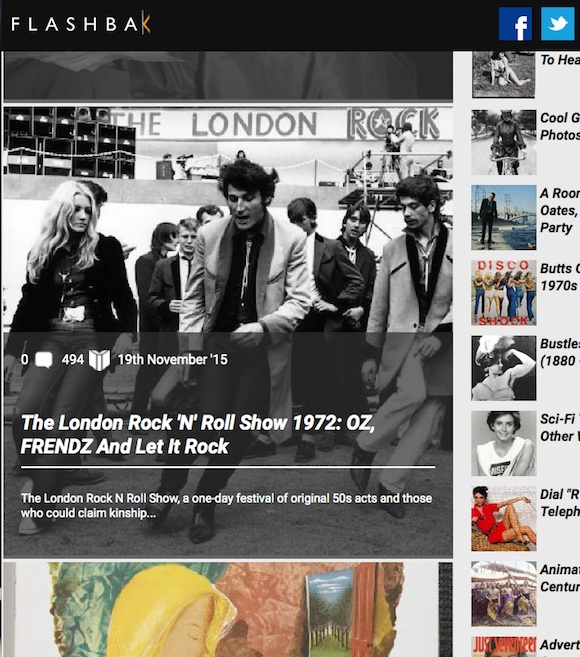
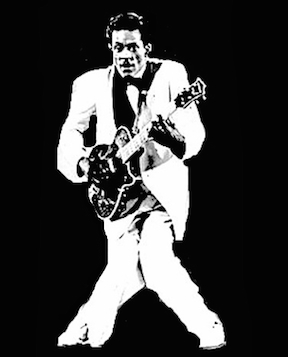
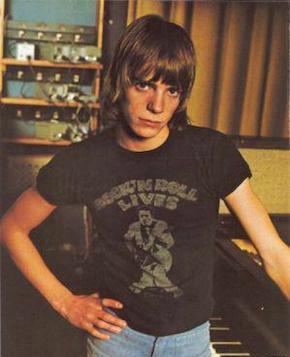
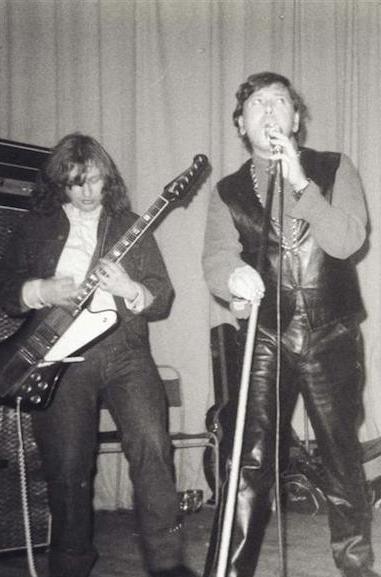






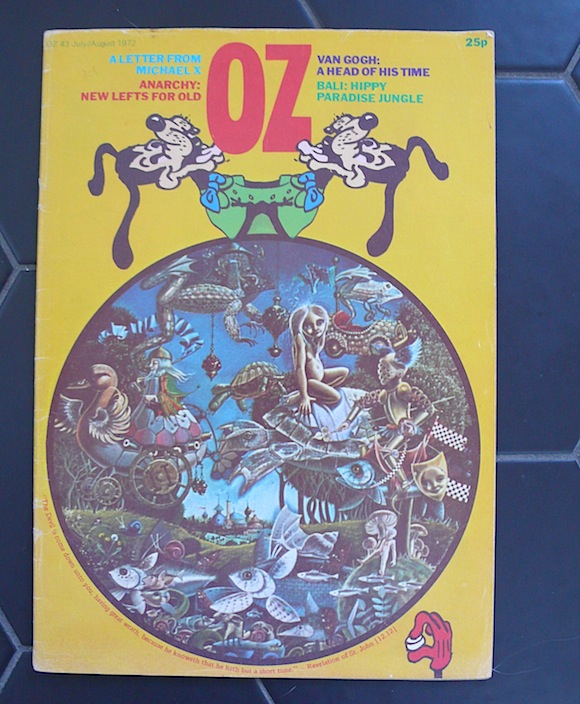
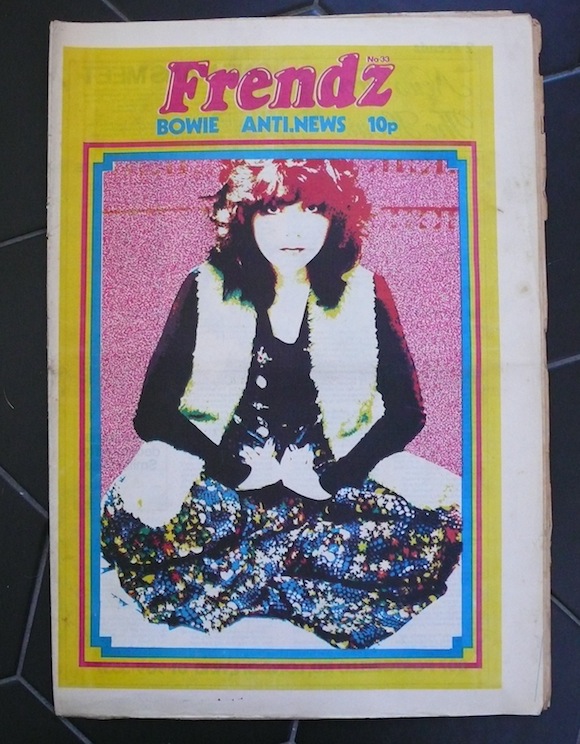
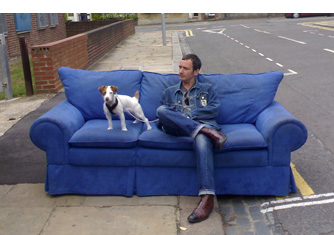






Recent Comments